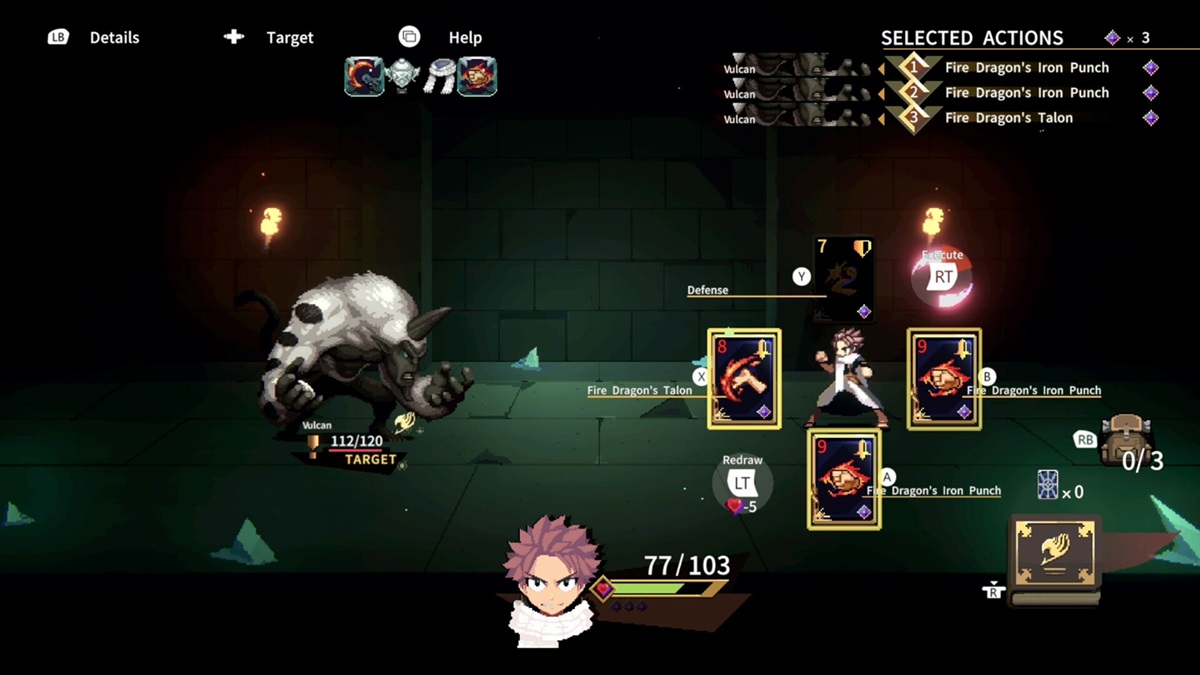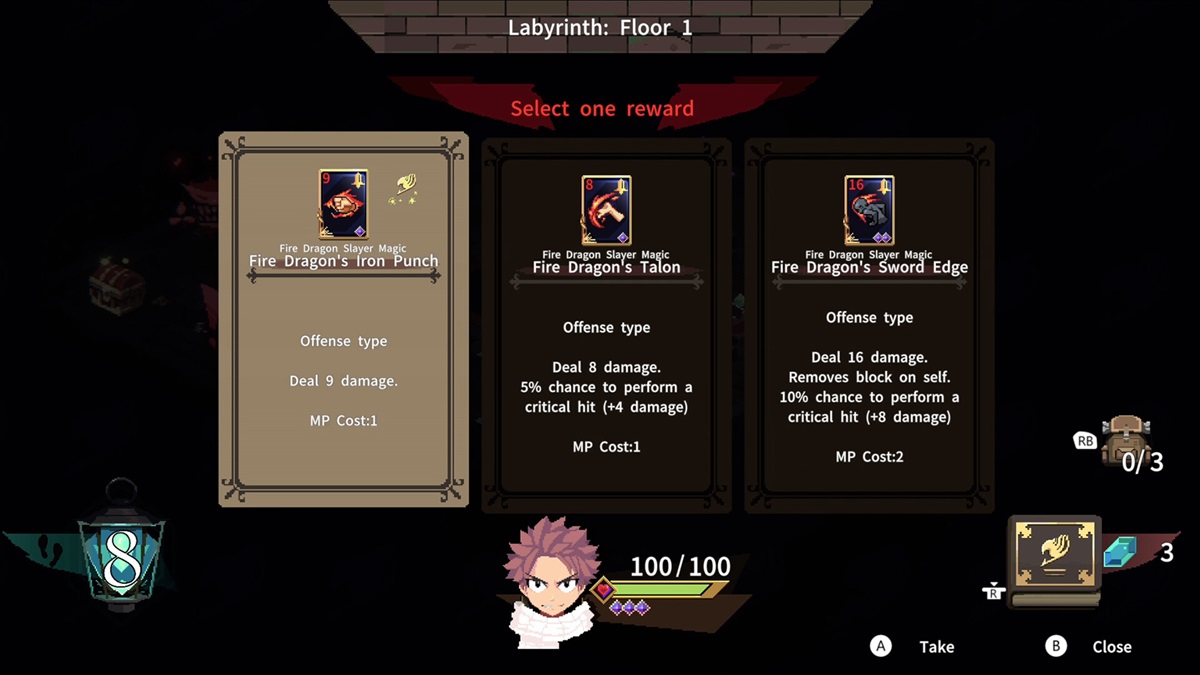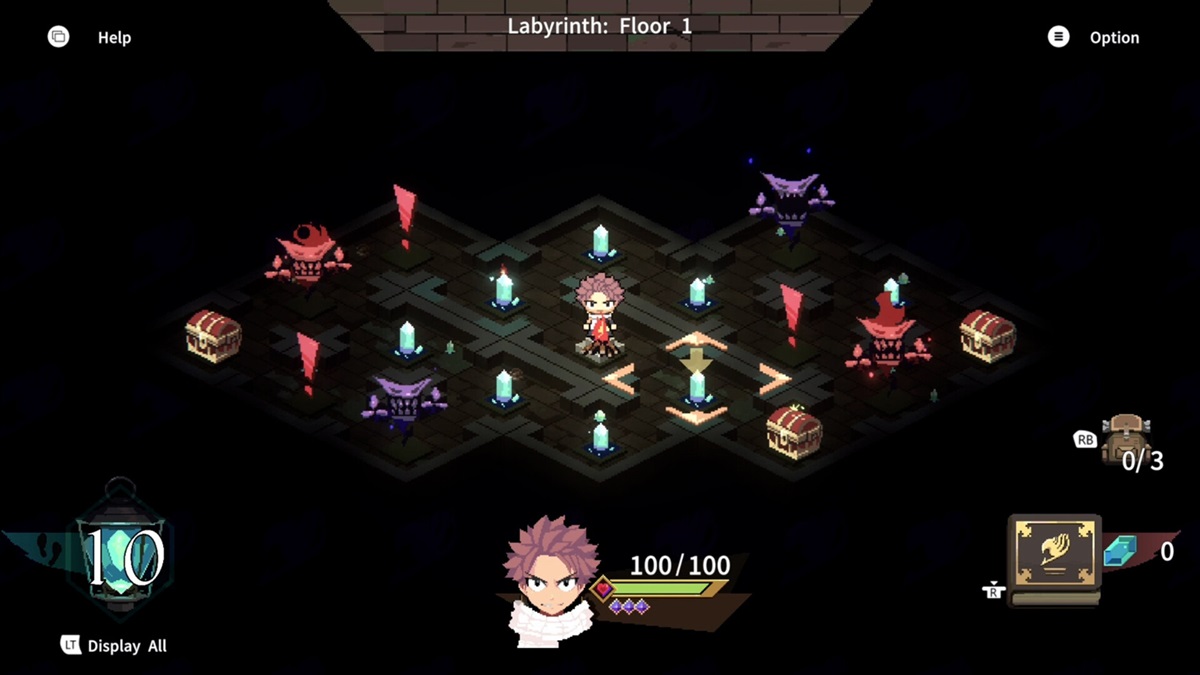Fairy Tail: Dungeons offers quick, snappy roguelite deck-building for someone looking for a few quick hands of high-stakes cards. Strikingly simple, but with some great depth to the systems you can quickly pick up, it’s highly entertaining whether you only have a few minutes to play or if you want to spend a good deal of time in its dungeon depths.
As someone with no knowledge of the anime, the game offers a fast introduction to some of the characters that felt like just enough to get you rolling. I was concerned that I’d be totally lost after the last few anime games that I’d played when I didn’t know the show, but this title doesn’t really need you to know much. It gives you a handful of playable characters (as well as some other ones you meet), but all you really need to know is their play style and how they fight. As this game is light on plot, it feels like you don’t lose anything from not knowing the show and you still feel like you “get” everything that’s happening. That said, this game is extremely light on plot, but I didn’t find I needed a story.
Instead, I was more focused on the card play. In Fairy Tail: Dungeons, you get a small deck of cards to play with at first. You get a mixture of attack cards that deal damage to foes as well as defensive cards that will block incoming damage. These cards area dealt to you four at a time, and you’ll start each round with a full hand of four. You’re given three MP every round you can use, and you get to decide how you spend those MP with your cards (most of which cost one or two MP to cast).

As for what you should do with your MP every turn, that depends on what your enemies are up to. The game will indicate some damage numbers beside the monsters if they’re going to attack you. If they’re not, you can select an enemy to figure out what sort of defensive or buff spells they may be casting instead. Enemies can also prepare highly-damaging attacks that come with unique ways of stopping them (play X number of attack cards, for example). Knowing everything your opponents are doing helps guide you in what you should do each round.
And while you only have four cards to choose from each round, it feels like you really need to think about what to play – you’ll agonize a lot over that simple hand. Should you bulk up your defenses? Try to kill something before it hits you? Prioritize playing the right cards to stop and incoming big hit (always do this one)? Your life points persist across the dungeon, so you can’t just blunder through a fight and then recover afterwards. Mistakes pile on, and if you take too much damage over several fights, you’ll be back to the start of Fairy Tail: Dungeons.
You’ll agonize quickly, though. With only a few cards to play, things move briskly through the game. There’s only so much you can do with each hand, so things hurry along. You can spend a bit of your life to redraw your hand if it’s utterly useless, but usually you’ll want to play what you have. This means you’re not usually taking too long to make your decisions, but there still feels like there’s a great depth every round despite the small hand size.

The real depth lies in building your deck and planning what possibilities you want to have in Fairy Tail: Dungeons. As you explore the dungeon map by choosing tiles to visit, you can pick up cards after fights, events you can stumble across, or shops that appear. Now, I loaded my deck with high-damage cards whenever I came across one, and while it worked great for a while, it eventually meant that my defensive cards didn’t show up as much when I was in combat purely because I had more attack cards in my deck. It was a pure probability thing that I had foolishly ignored in hopes of just slamming enemies. Not that playing more defensively got me any further a few rounds later. Still, I really liked that I had to consider how I was composing my deck for probability.
And there are several ways you can shape your deck. You can improve some of your capabilities in combat or add better abilities to specific cards using an upgrade system that costs Lacrima, a currency you pick up as you play. You can also just outright refuse some of the cards you’ve been offered, as well as prune a card from your deck at specific points. After a short time, it felt more important to remove cards, refuse to take them if I felt I had too many high cost cards, or to focus on just improving what I had to better know what to expect each hand rather than continually expand and mess up a predictable probability of getting the cards I wanted.
Still, there are some cool things that may make you really want to take that new card. Some cards can play off of one another to cause improved effects (Magic Chains), so you’ll want to ensure you get those often. But is adding a new chain worth it if it bloats your deck? Alternatively, you might unlock a new chain in your upgrade tree that you’ll wish you had picked up a card for earlier. It gave me a lot to think about as I sat mulling over whether to take a card or not.

How you stack that deck also depends on the character you use in Fairy Tail: Dungeons. Natsu plays offensively but is still more an all-rounder, but Gray plays more defensively, stacking up huge amounts of protection against damage. Lucy offered some more buffs and support casts. The playable characters give some fun options on how to play and build your deck, and their abilities all look very different from each other’s adding some nice visual flair and variety.
You also have a fair amount of wiggle room in how you play based on the map as well. Not every tile you can reach is an encounter. There are spaces that have you meeting other characters and having events, tiles with Lacrima on them, and shops as well. You can only see so far ahead so you can’t fully plan your route, but you can shoot for paths with fewer fights to preserve life (or more if you want better rewards). How you walk matters as much as how you play your cards.
And when you die (and I died a lot), you gain points towards a rank that unlocks amulets for future runs. These rarely offered extreme bonuses, but can give you little boosts in health, the probability of getting zero cost cards, the ability to carry more items (which is limited gear that can also give you some nice effects), and more. They don’t really break the game so I never felt like I was gaining overwhelming power, but it was enough to get a little leg up here and there.
Fairy Tail: Dungeons feels like a straightforward, but still nicely tactical, deck-building game. Being able to play a few quick hands in a fight was great for moments when there wasn’t much time to play, and the ability to dive right in and pick up the rules in seconds made it easy to just jump right into. Even so, the systems underneath had enough depth that it kept pulling me back in to reshape my strategies for the next run.
Fairy Tail: Dungeon is available for PCs.
Fairy Tail: Dungeons is a deck-building rogue-lite featuring characters from the Fairy Tail series. Collect Magic Cards based on moves from the series to build your own unique deck and take down powerful monsters as you head for the dungeon depths!
Fairy Tail: Dungeons is fast and straightforward, but still offers interesting depth with its deck composition to keep bringing you back.
- It's very easy to pick this game up and figure out the nuances of its cards system in moments.
- Despite this simplicity, deck composition and card choice as well as enemy capabilities will keep adding depth that keeps the game interesting.
- Characters provide some fun new ways to play and whole new attack visuals.


Published: Sep 7, 2024 12:00 pm